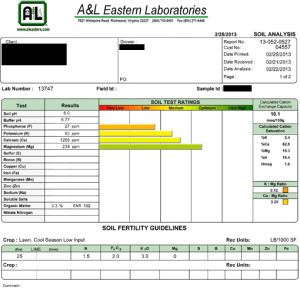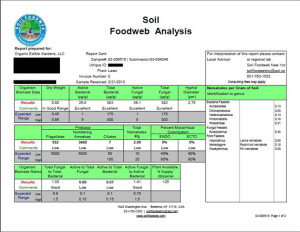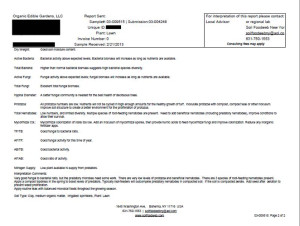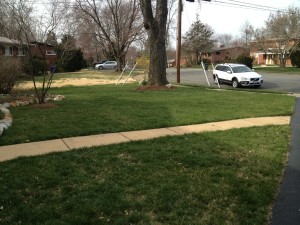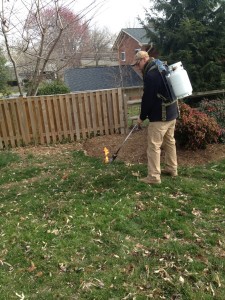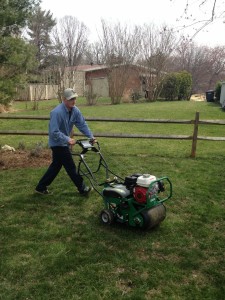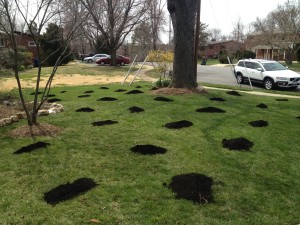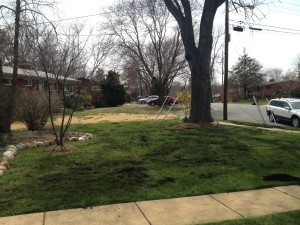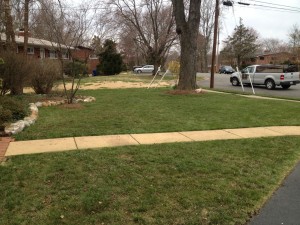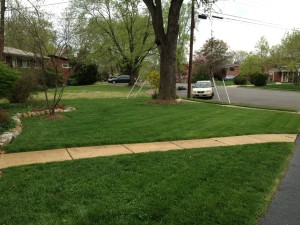©2013 by Jon Storvick and Organic Edible Gardens, LLC
Our previous article on ecological lawn care was an introduction to how the ubiquitous and toxic-chemical-addicted American lawn can be transformed in a safe, non-toxic, eco-friendly manner. Now we’re going to show you a little of what that actually looks like in practice.
We have been working with one of our clients in McLean for several years now, designing and maintaining various plantings organically. However, they retained their existing lawn service, which treated the lawn with chemical fertilizers and pesticides. Despite all of the toxic chemicals, unsightly weeds still flourished in the lawn. They decided to try out our organic lawn maintenance service as an alternative. Here’s what we’ve been doing as part of the process of converting their lawn to an organic ecosystem.
First off, we needed a snapshot of exactly what the conditions were in the lawn ecosystem. We took several soil samples from the lawn areas, and sent them off to two different sources – one examined the chemical and nutrient levels, and the other analyzed the biological activity in the soil – bacteria, fungi, protozoa, nematodes, etc.
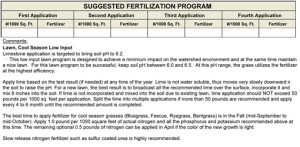
The chemical analysis indicated low levels of phosphorus, potassium and calcium, as well as a slightly lower pH than desirable. Organic matter was at 3.3%, where 6-8% would be more ideal.
The biological analysis indicated a much better microbial soil food web than we had anticipated – fungal and bacterial levels and diversity were good, but protozoa and beneficial nematodes were low. There were also higher levels of “pest” nematodes than were desirable.
We devised a strategy for increasing lawn health and converting to organic management based on these test results.
We arrived at the property in early April – we’ve had a belated Spring, so this was one of the first weeks where soil temperatures were high enough that we could proceed without harming the grass. Here’s a before shot of the lawn:
We began by organically removing much of the weeds in the lawn – hand removing taproot and bulb species like spring onions and dandelions, and flame weeding the rest (yes folks, this is safe, and we take all necessary precautions before using open flame in the landscape!).
We then gave the lawn its first mowing of the year, leaving the grass clippings in place. After mowing, we aerated the lawn to increase oxygen levels in the soil, decompact the hard clay, and allow for organic material to penetrate the soil surface.
After aeration, the next step is to topdress with lime and a good amount of compost.
We then spread the compost over the lawn.
After this is completed, we heavily overseed with our custom mixes (composed of various grasses, legumes for nitrogen fixation, and selected broadleaf species to fill open niches in the lawn ecosystem), and topdress with alfalfa meal, which slowly adds nitrogen and other nutrients through decomposition.
As we left, the lawn doesn’t look much different from when we started – but this will give it the initial start it needs to be healthy and organically maintained. In the future, we’ll be treating it with compost teas to feed the soil life, among other sustainable management techniques. We’ll keep you posted to show you how this new organic lawn turns out!
UPDATE 4/19/2013
After just 2 weeks, this is what the lawn looks like! Amazing!
For more information on organic lawn care, please visit the NOFA Organic Landcare website, or call Organic Edible Gardens LLC at 571-282-1724 for a free consultation.

